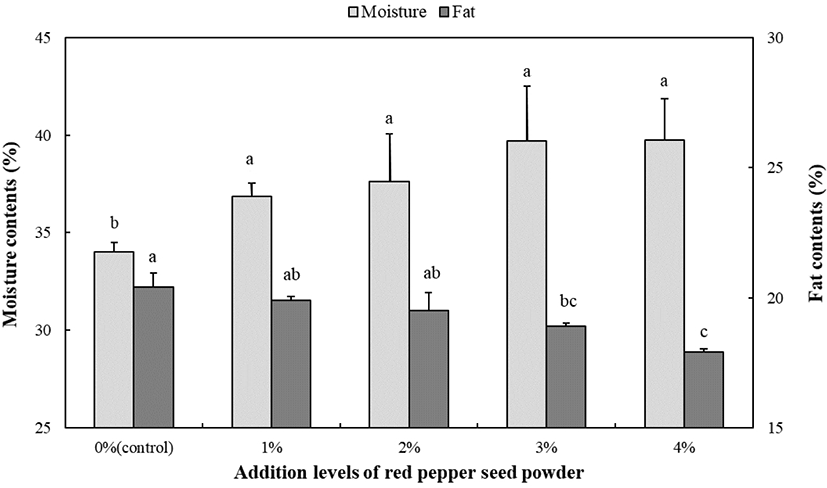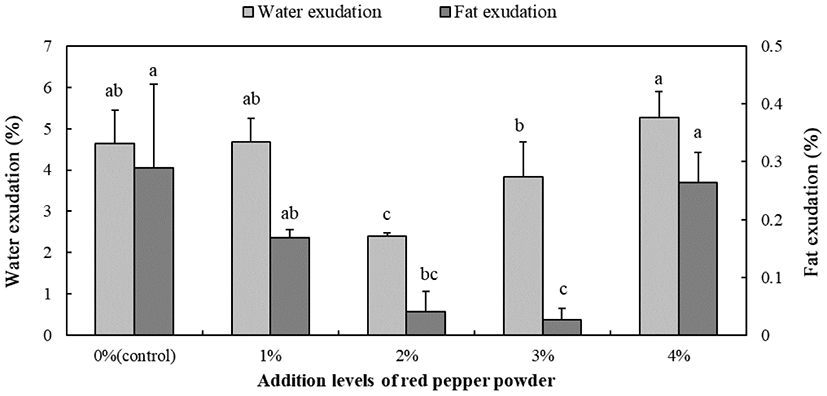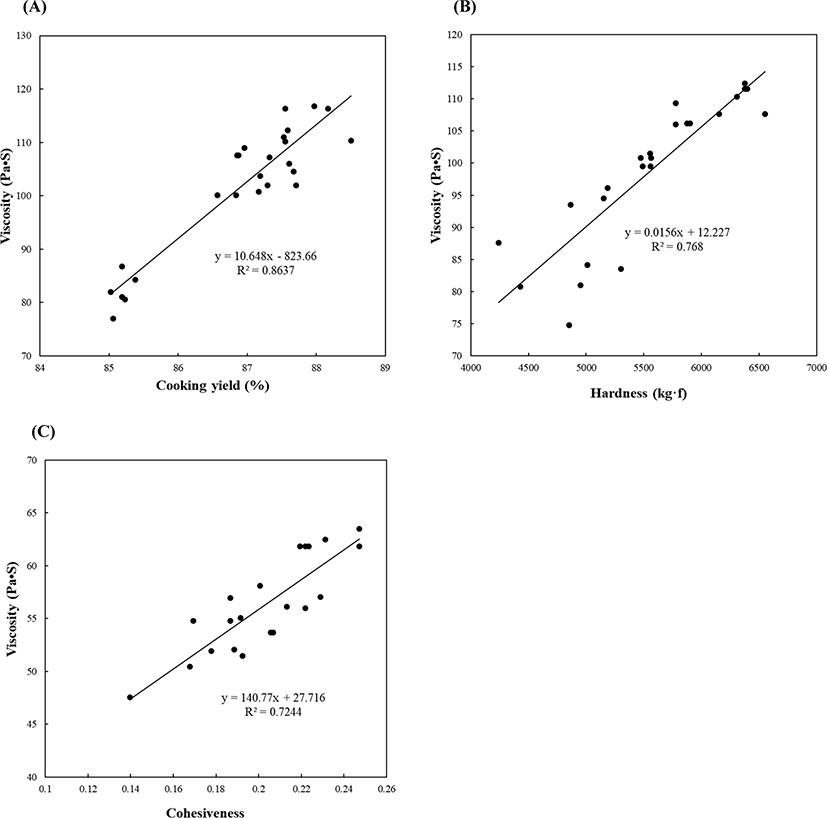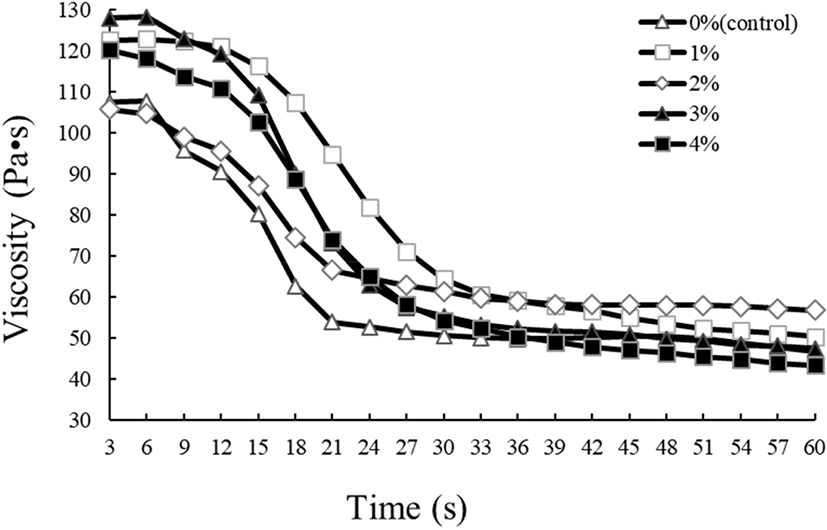Introduction
Red pepper (Capsicum annuum L.) is one of the most commonly consumed spices in Asian cuisine. In Korea, the red pepper is mostly consumed as a dried powder and the consumption per capita of which reached 3.7 kg in 2015 (Kim et al., 2017). In general, the seed of the red pepper is mostly removed prior to drying as a high seed content causes a deterioration in redness and in the flavor of the red pepper powder (Ku et al., 2008). However, the red pepper seed (RPS) contains 40%–65% dietary fiber (Lee and Kim, 2016) and has both antioxidant and antimutagenic activity (Sim and Han, 2007).
Dietary fiber is used in processed meat products, attributing both health benefits for the consumer and desirable qualities for the products including water holding/binding capacity, oil holding ability, and textural or sensory properties (Rafiq et al., 2018). In particular, viscosity is an important parameter in emulsified meat products due to its close relationship with water holding or retention capacity as measured by internal friction or resistance to flow (Bourne, 2002). Ding et al. (2018) observed that the addition of 1% chia seed powder exhibited enhanced the water holding capacity, presented lower purge and centrifugation loss, and had similar textural properties by panel compared to samples without. In addition, Kaur et al. (2015) found that chicken nuggets containing pomegranate seed powder exhibited desirable sensory properties but with no change in emulsion stability or moisture content. In another study, the addition of pomelo peel to chicken emulsion-type sausages led to remarkable increases in viscosity, emulsion stability, and moisture content in comparison to those without (Srithongkerd et al., 2018). As mentioned above, many authors tried to incorporate with dietary fiber obtained from agricultural by-products into meat products for enhancement in physicochemical properties (Choe et al., 2017; Selani et al., 2016). While many of these studies examined the effects of RPS powder on restructured or emulsified meat products for improvement of physiochemical properties, to our knowledge, rheological characteristics including emulsion stability and/or viscosity were not determined (Kim et al., 2013; Lee et al., 2016a; Lee et al., 2016b). Hence, the aim of this study was to determine the effects of RPS powder on the physicochemical properties of a meat emulsion model, including moisture and fat contents, pH values, instrumental color, cooking yield, emulsion stability, viscosity, and textural properties.
Materials and Methods
The RPS powder was purchased from a local market (Chungnam, Korea), sifted through a 35-mesh sieve, and stored at −20°C until use. To prepare the meat emulsion sample, the hind leg meat and back fat from pork were first purchased from a local butcher (Hongju meat Co., Chungnam, Korea). All subcutaneous and intramuscular fat and visible connective tissues were removed from the pork muscle; these were then cut and ground using an 8-mm plate grinder (PA-82, Mainca, Barcelona, Spain). Next, the ground meat (60%) was mixed with back fat (20%), iced water (20%), nitrite pickling salt (1.2%; nitrite content: 6,000 ppm), phosphate (0.3%), sugar (1%), mixed spice (0.6%; Bockworst, Raps GmbH & Co., Krombacher, Germany), and RPS powder at different concentrations [0% (control), 1%, 2%, 3%, and 4%] in a silent cutter (K-30, Talsa Co., Valencia, Spain). During the meat batter preparation, the temperature of the mixture was maintained below 10°C. The meat batter was then divided into two parts. One portion was used for measurement of pH values, color, cooking yield, emulsion stability, and viscosity, whereas the other portion was stuffed into a collagen casing (#240, NIPPI Inc., Tokyo, Japan; approximately 25-mm diameter) using a stuffer (EM-12, Manica, Barcelona, Spain) and cooked using a water bath (JSWB-30T, JSR, Gongju, Korea) at temperature 80±1°C until the internal temperature of the samples reached 75°C. The samples were subsequently cooled in iced water for 30 min, vacuum packed, and stored at 4°C until moisture and fat content, pH, color, and textural properties could be analyzed. All processing was performed in triplicate.
Moisture and fat contents of the cooked samples were determined using the method described by AOAC (2012). Moisture content (AOAC method 950.46B) was determined by measuring weight loss after 12 h of drying at 105°C in a drying oven (SW-90D, Sang Woo Scientific Co., Bucheon, Korea). Fat content (AOAC method 960.69) was determined using the Soxhlet method in a solvent extraction system (Soxtec® Avanti 2050 Auto System, Foss Tecator AB, Höganas, Sweden).
The pH values for a mixture of sausage samples and distilled water (1:4) were determined using a pH-meter (Model 340, Mettler-Toledo GmbH Analytical, Schwerzenbach, Switzerland). The cooking yield in each treatment was determined by weighing meat batters before and after cooking and expressed in percentage.
The color of the samples was examined using a colorimeter (CR-10, Minolta, Japan; illuminant C, calibrated with a white standard plate L*=97.83, a*=−0.43, and b*=+1.98), which had a measuring area with a diameter of 8-mm and an illumination area of 50 mm diameter. Color values (CIE L*, a*, and b*) were measured on the surface of samples with results taken in triplicate for each sample.
The meat batter samples from each group were analyzed for emulsion stability using the method described by Choe et al. (2013). The 15-mesh sieve (with 50-mm diameter) was placed in the middle of a graduated glass tube. Approximately 25 g of the meat batter was weighed and placed on the sieve in glass tubes and covered. Triplicate samples from each group were cooked at 75±1°C for 30 min, followed by cooling to approximately 4±1°C in order to facilitate fat and water layer separation. The fluid water and fat, which separated well in the bottom of the graduated glass tube, were measured in milliliters and calculated as a percentage of the original weight of the batter.
The cooking yield of each group was determined by weighing meat batters before and after cooking and expressing this as a percentage.
The flow behavior and time dependence of the batters were investigated at 20±1°C using a parallel plate rotational viscometer (HAKKE Viscotester 500 R®, Thermo Electron Corporation, Karlsruhe, Germany). The batter allowed to equilibrate for 5 min at room temperature (23±3°C) and was tested using a standard cylinder sensor (SV-2). Time dependency of the batter viscosity was determined by measuring the apparent viscosity under a constant shear rate of 10/s for 60 s.
Cooked samples, cut into sections with a height of 25 mm and φ 16 mm diameter, were used in this study. A cylinder probe (φ 20 mm diameter) set attached to a Texture Analyzer (TA-XT2i, Stable Micro System Ltd., Surrey, UK) was used to examine the textural properties for each sample. The test conditions used in the study were as follows: stroke, 2 kg; test speed, 2.0 mm/s; and distance, 8 mm. The texture profile analysis (TPA) parameters, thus hardness (N), springiness, cohesiveness, gumminess (N), and chewiness (N) were collected.
All experiments were repeated three times. Statistical analysis was performed by one-way analysis of variance (ANOVA), and significant differences (p<0.05) were detected by Duncan’s multiple range test using SAS software (SAS, Release 9.3 for window, SAS Institute Inc., USA). The values are expressed as means SD.
Results and Discussion
The addition of RPS powder to the meat emulsion significantly influenced the moisture and fat contents (Fig. 1). The amount of RPS powder added had no effect on the moisture contents (p>0.05), similar to the results of Lee and Kim (2016) for restructured meat products with RPS powder. Addition of RPS powder at levels higher than 3% led to a significant decrease in fat contents of samples compared to that of the control. Moreover, samples with 4% RPS powder showed the lowest (p<0.05; 12.2% reduction) fat contents among all the groups. This result may be linked to fat binding ability of RPS powder based on result of fat exudation which showed the highest (p<0.05) by addition of 4% RPS powder in emulsion samples (Fig. 2). Previous study observed moisture content was increased and fat content was decreased (weight percentage basis) in sausage samples as increasing addition level of oat bran which is soluble fiber (Chang and Carpenter, 1997). In hence, we speculated that PRS powder probably contains large amounts of soluble fiber.

The pH was affected both by the amount of RPS powder added and by heat treatment (Table 1). The higher (p<0.05) pH of samples with RPS powder were most probably caused by the pH value (pH 6.25) of the RPS powder alone. Interestingly, in this study, samples with 1% RPS powder showed the highest pH values among the samples containing RPS powder. After cooking, the pH had increased in all groups. This phenomenon may be due to the protonation of imidazole groups which could be exposed as a result of protein denaturation at the temperatures used for cooking (Tanford, 1968). Xiong et al. (1999) reported a different observation whereby meat batter with a higher pH than the isoelectric point (pI) rarely showed a pH increase after heat treatment.
The color of meat and meat products has a large influence on consumers purchasing decisions, and is therefore an important parameter (Choe et al., 2017). In this study, it was found that the addition of RPS powder and the amount added resulted in a change of color (L*, a*, and b*) (Table 1). In general, in all samples, by increasing the amount of RPS added, L* values decreased and a* and b* values increased (p<0.05), regardless of cooking. Similar results have been observed in sausages where significant decreases of L* values were related to an increase in apple and orange fiber concentration (Garcia, 2007). In this study, the increase in a* and b* values was probably caused by the intrinsic color of the RPS powder (L*, 53.50; a*, 24.46; b*, 22.10). Based on these results, incorporation of RPS powder into meat products can lead to a positive change in a* values, whilst to a negative change in b* values.
Emulsion stability is critically affected by the properties of proteins, water and fat retention or absorption capacity of non-meat ingredients in emulsified products (Haque et al., 2016; Zorba and Kurt, 2006). In addition, the pH values of samples can influence emulsification and the functional characteristics of emulsion; pH values further away from the pI possess greater emulsifying stability (Cheftel et al., 1985; Zorba and Kurt, 2006). In this study, regarding non-meat ingredients, water and fat exudation were dependent on the amount of RPS powder added (Fig. 2). Among the groups, significantly lower values of water and fat exudation were observed in emulsified samples containing 2% RPS powder. Additionally, the addition of 3% RPS powder showed decreased (p<0.05) in fat exudation. The addition of RPS powder at higher levels (4%) induced an increase in water and fat exudation. These results indicate that the addition RPS powder at optimum levels (2% or 3%) forms a matrix which may be effective at holding or absorbing water and fat during protein gelation. The emulsion stability of samples is closely related with cooking yield loss. According to Surh et al. (2006), emulsified samples with high stability showed low levels of water and fat exudation during cooking, hence presenting highly sought after properties. In this study, the cooking yield of samples was affected by the addition of RPS powder and the amount added (Table 1). The lowest (p<0.05) cooking yield was observed in samples without RPS powder while significant differences in yields were not observed among the groups with RPS powder at amounts up to 3%, with 3% RPS powder exhibiting the highest cooking yield. A similar trend to that of the emulsion stability analysis was observed in that the higher level (4%) of RPS powder added led to a deterioration in the water holding capacity of the samples and therefore a lower cooking yield.

The apparent viscosity of the meat emulsion samples, which ranged from 47.5 to 128.29 Pa•s, decreased with increasing rotation time (Fig. 3). The samples without RPS powder had the lowest values (p<0.05) up until 30 s while, thereafter, samples with RPS powder added at 0% and 4% had the lowest values (p<0.05) of apparent viscosity. In general, the addition of RPS powder at 1%, 2%, and 3% led to the similar values (p>0.05) in apparent viscosity of the meat emulsion samples. In general, the addition of dietary fiber brought about an increase in viscosity in bologna samples regarding many fibers possess high fat absorption ability and WHC (Claus and Hunt, 1991; Saricoban et al., 2010). However, in this study, the addition of RPS powder at 4% induced decline in viscosity compared to samples with RPS powder at 1%, 2%, 3%, which was probably affected by the poor fat absorption ability (based on fat content) as adding large amounts of RPS powder. Furthermore, according to Dhingra et al. (2012), incorporation of fiber with highly branched or short chain polymer can lead to low viscosity depending on addition level, although having high WHC. Like emulsion stability, viscosity of meat emulsion can change depending on the water-holding capacity of non-meat ingredients including dietary fiber. Choe et al. (2013) showed a negative correlation between viscosity and cooking loss (r2=0.8305) in meat batter samples with wheat fiber and pork skin. Similarly, in this study, viscosity of the emulsion samples exhibited positive correlation with cooking yield [r2=0.8291; Fig. 4A].

As shown in Table 2, textural properties (hardness, springiness, gumminess, chewiness, and cohesiveness) were partially affected by addition of RPS powder and by the amount added. Textural properties are important parameters for consumer preference and are closely related to the viscosity of emulsion samples. A previous study reported that high-viscosity meat batter exhibited greater textural properties, except for springiness (Choe et al., 2013). In this study, higher values (p<0.05) in hardness and springiness were observed in samples with RPS powder at 4% and 3%, respectively. This result partially agreed with the finding of several authors who reported that hardness is generally increased as decreasing in fat content in meat emulsion consisting of same meat protein content (Colmenero et al., 1995; Lee et al., 1987). For gumminess, chewiness, and cohesiveness, the addition of RPS powder at 1%, 2%, and 3% showed the highest values (p<0.05). Furthermore, positive correlations between viscosity and hardness [r2=0.7444; Fig. 4B] and viscosity and cohesiveness [r2=0.7118; Fig. 4C] were observed in the emulsion samples. The relatively lower correlation coefficients herein were presented than that between viscosity and cooking yield.
Conclusion
Based on the results of this study, addition of the optimum amount of RPS powder (2%) to emulsified meat products would lead to an enhancement in the quality of characteristics associated with these products. In particular, addition of 1% RPS powder would have a potent effect on the color of meat products due to its bright red color and acceptable increase in yellowness.














